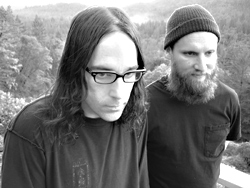Meditative, restrained, and minimalist aren’t adjectives typically associated with heavy music in general or heavy metal in particular. But there’s little typical about the hypnotic, brain-scrambling sounds unleashed by bassist-vocalist Al Cisneros and drummer Chris Hakius in the potent psych power duo Om. As the lumbering rhythm section of the late, lamented San Jose sludge-metal revivalists Sleep, Cisneros and Hakius (along with guitarist and current High on Fire main man Matt Pike) put an epic twist on the Black Sabbath template for a new generation of headbangers during the ’90s. A disastrous major-label fiasco shelved Sleep’s now legendary hour-plus opus, Dopesmoker, led to the band’s dissolution, and drove Cisneros from music entirely for almost five years.
When the bassist finally rediscovered his muse and reunited with Hakius in 2002, the pair could easily have hooked up with a new Tony Iommi disciple and stayed the course as Sleep Mark II. Instead, as Cisneros explains, he and his partner further distilled the monolithic riff science of their former group while aiming for a radical departure: “We didn’t want to do what we’d already done. Having a guitarist and playing music like we used to would be like playing covers. We just wanted to explore and be honest with ourselves in what we’re doing, even if nobody else understood it.”
It didn’t take long for the musicians to rekindle their near-telepathic interplay. “The first day we had a rehearsal as Om, we were able to explore parts of the sound that would not be possible if there was somebody else there waiting to play a part or insisting on us being a certain way,” remembers Cisneros. The music that emerged retained Sleep’s fascination with extended song forms and an infinite patience for gradually turning a riff inside out through repetition. As the title of the debut recording, Variations on a Theme, suggests, Om even revisited concepts from both Dopesmoker and earlier effort Sleep’s Holy Mountain. However, paring the instrumentation down to Hakius’ pulsing, metronomic thunder and Cis-neros’ overdriven bass drone and vocal incantations pushed Om into a different sonic realm of mesmerizing psychedelic mantras. Lyrically, Cisneros left behind his weed-fixated imagery for epic verse ruminations on flight and spiritual ascension that prod the listener toward an internal vision quest.
To hear the soft-spoken Cisneros discuss Om’s songwriting process, it seems the tunes are born through a channeling of forces the band has little control over: “Both Chris and I hear parts [in our heads], and we need to get them exactly the way we’re hearing them. [It] isn’t so much trial and error as an overwhelming, recurring visit of a theme or sound. Otherwise, you still carry them around . . . like this burning ore inside you,” says Cisneros.
There’s no denying the intensity of the cosmic vibrations brought forth on the band’s latest release, Conference of the Birds, for John Whitson’s not-so- coincidentally named local imprint, Holy Mountain. Opening track “At Giza” captures the languid interstellar pilgrimage of Pink Floyd’s early nugget “Set the Control for the Heart of the Sun” as it slowly flowers from a measured, spacious groove to a final, endorphin-releasing climax powered by Cisneros’ hyperdistorted Rickenbacker bass line.
“Flight of the Eagle” hews closer to the sound of Om’s first album, but similarly manages to warp the listener’s perception of time like a high-octane hit of windowpane acid. The two songs clock in at a little over half an hour, but through headphones, those 30-odd minutes stretch and bend in the best possible way. Given Om’s copacetic relationship with Whitson, the duo will continue to push the heavy-psych envelope with its unique brand of sternum-rattling exploration for years to come. “Honestly, we’ve never been happy with a record label until Holy Mountain,” says Cisneros. “It’s kind of a surreal feeling. We keep thinking, ‘Isn’t something supposed to go wrong now?’ And it hasn’t. We’re really happy.”




